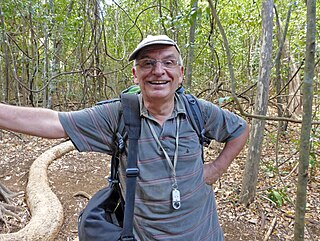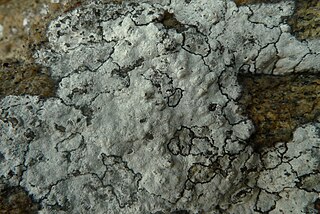
Ascomycota is a phylum of the kingdom Fungi that, together with the Basidiomycota, forms the subkingdom Dikarya. Its members are commonly known as the sac fungi or ascomycetes. It is the largest phylum of Fungi, with over 64,000 species. The defining feature of this fungal group is the "ascus", a microscopic sexual structure in which nonmotile spores, called ascospores, are formed. However, some species of the Ascomycota are asexual, meaning that they do not have a sexual cycle and thus do not form asci or ascospores. Familiar examples of sac fungi include morels, truffles, brewers' and bakers' yeast, dead man's fingers, and cup fungi. The fungal symbionts in the majority of lichens such as Cladonia belong to the Ascomycota.
An ascocarp, or ascoma, is the fruiting body (sporocarp) of an ascomycete phylum fungus. It consists of very tightly interwoven hyphae and millions of embedded asci, each of which typically contains four to eight ascospores. Ascocarps are most commonly bowl-shaped (apothecia) but may take on a spherical or flask-like form that has a pore opening to release spores (perithecia) or no opening (cleistothecia).

The Gomphillaceae are a family of lichen-forming fungi in the order Graphidales. Species in this family are found mostly in tropical regions.
Lasioloma is a genus of lichenized fungi in the family Pilocarpaceae. The genus was circumscribed by Swedish lichenologist Rolf Santesson in 1952, with Lasioloma arachnoideum assigned as the type species. Found predominantly in tropical rainforests, genus Lasioloma contains both foliicolous (leaf-dwelling) and corticolous (bark-dwelling) species. The foliicolous species are distinguished by their woolly prothallus, a thallus that ranges from dispersed to continuous, and a hairy apothecial margin. In contrast, corticolous species typically do not have a woolly prothallus, and their thalli are usually continuous, or unbroken. Regardless of the substrate they inhabit, all known Lasioloma species are characterized by the production of campylidia and branched conidia.

Candelariaceae is a family of lichen-forming fungi in the order Candelariales. It contains seven genera and about 73 species. The family was circumscribed by Finnish lichenologist Rainar Hakulinen in 1954 to contain the type genus, Candelaria.

Absconditella is a genus of lichenised fungi in the family Stictidaceae. The genus was circumscribed in 1965 by Czech lichenologist Antonín Vězda, with Absconditella sphagnorum assigned as the type species. Absconditella is characterised by gyalectoid apothecia with a hymenium that is not amyloid, without a dark pigment and thalli containing green algae as photobionts. The genus name means "hidden", a reference to the scant structure of the thallus and its small apothecia.
Taitaia is a single-species fungal genus in the family Gomphillaceae. It was circumscribed in 2018 to contain the species Taitaia aurea, a lichenicolous (lichen-dwelling) fungus. This species is characterized by aggregated ascomata with yellow margins, and salmon-red discs that originate from a single base. It is known only from a few sites in Kenya's tropical lower-mountain forests, where it grows on thalli of the lichen Crocodia.

Emmanuël Sérusiaux is a Belgian lichenologist. His career, spanning more than four decades, has combined both lichenology research and political aspects of nature conservation. He spent several periods working as a researcher at the National Fund for Scientific Research and the University of Liège, the latter in which he accepted a faculty position as professor and head of the Plant Taxonomy and Conservation Biology unit. Sérusiaux also served for three non-consecutive appointments as Deputy Chief of Staff in the Government of Wallonia. He retired from both his academic and political positions in 2019.

Lathagrium is a genus of lichen-forming fungi in the family Collemataceae. It has 10 species of gelatinous lichens. Species in this genus typically grow on calcareous rocks, often amidst mosses, but can also be found on siliceous or serpentine rocks, mortar, or soil.

Roccellographaceae is a family of lichen-forming fungi in the order Arthoniales. It contains three genera: Dimidiographa, Fulvophyton, and Roccellographa.
Sporopodiopsis sipmanii is a species of foliicolous (leaf-dwelling), crustose lichen in the family Pilocarpaceae. Found in Sabah, Malaysia, it was formally described as a new species in 1997 by Belgian lichenologist Emmanuël Sérusiaux. The type specimen was collected by Harrie Sipman from Mount Kinabalu; the species name sipmanii acknowledges him. The lichen produces asexual spores (conidia) within curved, dorsiventral structures called campylidia; the presence of apothecia in addition to campylidia readily distinguishes it from the other species in the genus, Sporopodiopsis mortimeriana.
Redonographa is a genus of lichen-forming fungi in the monogeneric family Redonographaceae. It has five species.
Asterothyrium vezdae is a species of foliicolous (leaf-dwelling) lichen in the family Gomphillaceae. It is found in Bolivia, where it grows on the leaves of vascular plants in the Amazon rainforest. The lichen is distinguished from its closest relative, Asterothyrium octomerum, by the larger number of septa in its ascospores, and its and black apothecia.
Podotara is a fungal genus in the family Pilocarpaceae. It is a monotypic genus, containing the single species Podotara pilophoriformis, an uncommon foliicolous (leaf-dwelling), crustose lichen that grows on Podocarpus totara, a species of podocarp tree endemic to New Zealand. Both the genus and the species were proposed in 1996.
Follmannia is a genus of lichen-forming fungi in the family Teloschistaceae. It has three species. All three species are crustose lichens, and all occur in South America.
Haloplaca is a genus of lichen-forming fungi in the subfamily Teloschistaceae of the family Teloschistaceae. It contains three species of crustose lichens. The genus was circumscribed by Ulf Arup and colleagues in 2013, with Haloplaca britannica assigned as the type species. The genus name alludes to the preference of its species for salt-rich environments. All three species occur in the United Kingdom, but H. suaedae also occurs in Greece, Morocco and Turkey. Haloplaca species occur near the sea, either on rocks or on plant debris.

Erichansenia is a genus of lichen-forming fungi in the family Teloschistaceae. It has three species of saxicolous (rock-dwelling), crustose lichens.
Calogaya orientalis is a species of corticolous (bark-dwelling) and muscicolous lichen (moss-dwelling), crustose lichen in the family Teloschistaceae. It is found in arid steppe and desert habitats in Northwestern China, Iran, and Turkey. The thallus of this lichen is reduced, similar to species in the genus Athallia.
Schaereria porpidioides is a species of saxicolous (rock-dwelling), crustose lichen in the family Schaereriaceae. It is found in the Falkland Islands.








